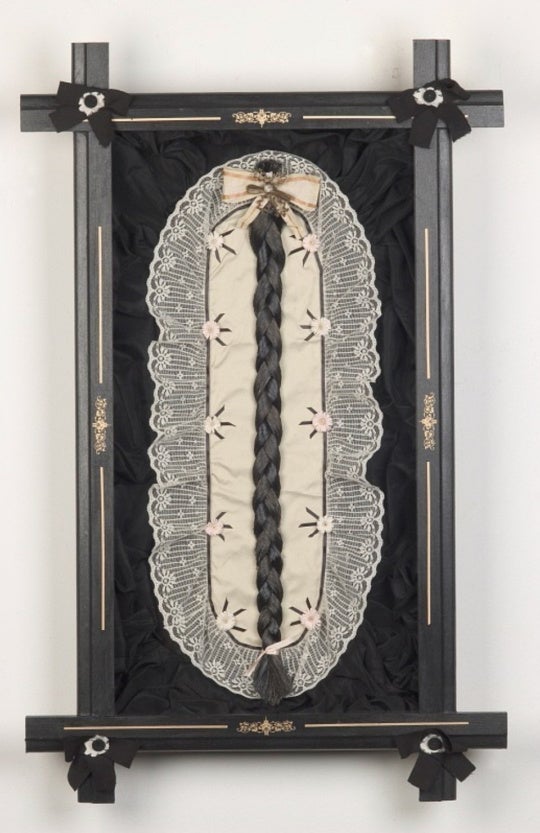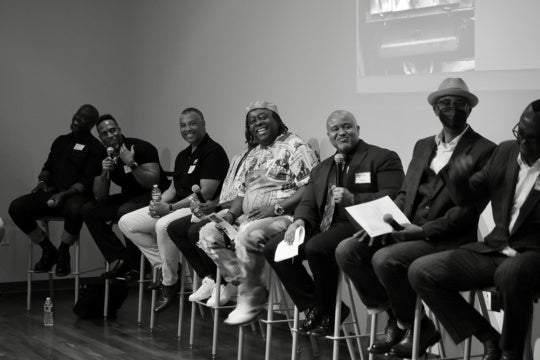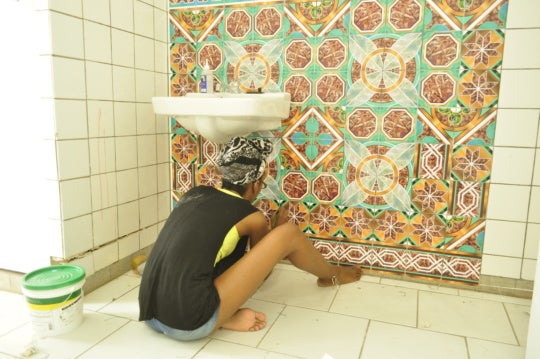
Marcus Kenney: Underneath the Hope, currently on view at Marcia Wood Gallery, conjures up visions of a Southern shamanic den. Black-and-white photographs peppering the walls seem like portholes into strange rituals while totemic objects line the walls and floor. The works are beguilingly playful, yet impart an underlying sense of disturbance.
Marcus Kenney is a son of the South. Originally from rural Louisiana, he has lived in Savannah for the past 15 years. His works cover an incredible range of mediums, from paintings that contain heavy collage elements, to sculptures that combine taxidermy, found objects, jugs, furniture, dolls—a fully inclusive list of materials is an exercise in futility. (Background on the artist’s two previous exhibitions at Marcia Wood can be found in this review and audio program by BURNAWAY.) Underneath the Hope also features new photographic works in what marks a return to the medium for Kenney.
The first work visitors will encounter is Sebastian, a ratty-looking piece of taxidermy adorned with blonde pigtail braids, a crown of barnacles, and an American-flag cape. Its face is painted a mask-like white and its torso punctured with an arrow. The title and arrow reference Saint Sebastian, who was killed during the Roman persecution of Christians. Dolled up with colorful beads yet bound and trussed, Sebastian sets a tragicomic tone for the exhibition.

Indeed, Underneath the Hope features a menagerie of creatures and people that would be unsettling if not for a strong vein of mischievousness running through the works. Two wooden oars grace the walls: their paddles look like victims of a thwarted yarn-bombing, and their shafts are covered in layers of twine and fur like an ineptly wrapped mail package. Wary-eyed baby dolls painted black, tan, or a fiendish silver sit like effigies throughout the gallery, near various jugs and masks decorated with yarn, fur, paint brushes, and pieces of knit clothing, among other materials. This grab-bag of decorations extends to the other pieces of taxidermy, such as the adorably punk Small Creature, 2012, a rodent-like animal bedecked in various colorful pins and buttons crowned with a Mohawk-like tuft of fur.
The photographs in this exhibition set the scene of a complicated mystical wildness. In Talk to the Hand, 2012, a black man crouches by a brick wall near a web of dry branches and chain-link fence. He holds a mask of a white man’s face over his own; his free hand is held out as if to warn the viewer to back away. The man’s outstretched hand casts a shadow that ominously seems to reach towards its owner as if to grasp him. Kenney has added collage elements to the photograph, accentuating the frightened eyebrows and wide blue eyes of the mask. He also outlines the lips in red, emphasizing the clown-like aspects of the mask and bringing to mind the lip-exaggerating makeup of black-face actors. It is ambiguous whether the man is feigning terror and playing a game, or has backed up into a corner to defend himself from some real danger.
Where Talk to the Hand references a problematic racial history, Portrait 2, 2012, is a celebration of wild and unruly nature. A woman looks directly into the camera, her hair a tangle of golden curls. Kenney has added collage to this image as well, giving the woman a pair of kindly cat’s eyes, a yellow mask, and a white mustache that all accentuate the lion-like aspects of her mane. A ringlet of wildflowers forms an upside-down horseshoe over the mask. The lovely yet somber result seems half druid, half Aslan (the Christ-like lion from C.S. Lewis’s The Chronicles of Narnia).
Although Portrait 2 and Talk to the Hand portray seemingly disparate scenarios, in fact they reveal a subtle interplay with conceptions of Southern rural identity. These romanticized ideas feature beautiful wild children with freckled shoulders, clothes askew, and hair turned golden in the sun. Yet this vision also includes the complicated history of race relations and a reality of continued hostility.
Kenney’s adherence to yarn and stuffed animals brings forth similarities to the late Mike Kelley, another artist whose works ran the gamut from assemblage to collage. Kelley often used found crocheted blankets and fabric dolls to make sculptures both disturbing and innocent. Many of Kenney’s works seem to pull inspiration from Kelley, especially works like State of Nature, 2012, which features a Ronald McDonald doll pinned like a voodoo doll. Kenney’s Pilgrim, 2012, an impish hobo-like doll, has “MK” tagged on his foot. These initials correspond to both Kenney and Kelley, deepening the sense of lineage.
Kenney’s use of soft materials and playful elements creates an entry into complicated discussions of place without lessening their impact. Like a shaman, his message is brought forth using symbols and natural totems; like Shakespeare’s fool, he sees through deceptions but can only convey the truth through riddles.
Marcus Kenney’s exhibition, Underneath the Hope, continues at Marcia Wood Gallery through Saturday, October 20, 2012.




